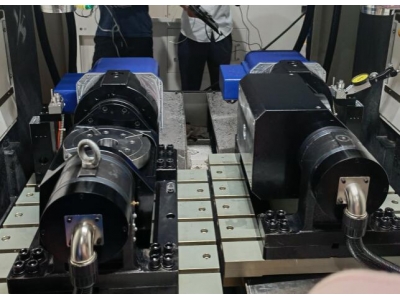一、西瓜如何下刀?
1、首先用西瓜刀將西瓜切成兩瓣。
2、然后用專用切西瓜塊的刀,在切開的西瓜中切。
3、再按照相同的方法再在西瓜瓤上刮動。
4、在刮動的時候,盡量保持自己的手不要抖動。
5、然后將切好的西瓜用刀背夾起來,放進盤子就完成了。
二、cnc數控機床下刀位置怎么改?
數控機床下刀位置的更改可以通過以下步驟實現: 確定要更改的下刀位置。
在數控機床控制面板上,找到并按下“設置”或“參數”按鈕。
進入“下刀位置設置”菜單。
使用方向鍵或旋鈕,選擇要更改的下刀位置軸(X、Y或Z軸)。
輸入新的下刀位置值。
按下“確認”或“保存”按鈕,將新的下刀位置值保存到數控機床的內存中。
重新啟動數控機床,使新的下刀位置值生效。
三、數控機床編程循環技巧大揭秘!
數控機床編程循環技巧大揭秘!
數控(machine control)機床是一種能夠自動執行預先編程的指令序列來控制工具運動和加工工件的機床,廣泛應用于制造業。在數控機床編程中,循環(cycle)是一個非常重要的概念,它能夠大大提高數控加工效率。本文將為您揭秘數控機床編程循環的技巧和要點。
循環編程的基本概念
循環編程是指在數控機床的程序中通過循環結構重復執行某一段指令序列的方法。在實際加工過程中,常常會遇到一些需要重復執行的加工工序,比如孔加工、螺紋加工等。使用循環編程可以簡化程序結構,提高編程效率。
數控編程中的循環類型
在數控編程中,常用的循環類型包括:
- 固定循環:在程序中指定循環次數進行重復執行。
- 條件循環:根據設定的條件來決定是否繼續循環執行。
- 循環調用:在程序中調用定義好的循環子程序進行重復執行。
循環編程的技巧
要想熟練掌握數控機床編程中的循環,需要掌握以下幾點技巧:
- 合理設計循環:在編程時要根據加工工件的特點和加工工藝合理設計循環結構,避免出現冗余和重復的指令。
- 掌握循環控制指令:熟練掌握循環控制指令,如循環開始、循環結束等,確保循環能夠正確執行。
- 注重循環精度:確保循環執行的精度,避免出現因循環誤差導致的加工偏差。
- 循環優化:不斷優化循環結構,提高編程效率,減少加工時間。
總結
通過本文的介紹,相信您對數控機床編程循環有了更深入的了解。掌握好循環編程技巧,能夠極大提高數控加工效率,優化加工質量。在實際編程過程中,不斷練習和總結經驗,相信您會成為一名優秀的數控機床編程師!
感謝您看完這篇文章,希望對您在數控機床編程循環方面有所幫助!
四、加工中心循環下刀程序怎么編,銑外形?
下刀時用增量方式編程再調用子程序就下去了
五、精雕刀具如何分層下刀
精雕刀具如何分層下刀
刀具是制造業中必不可少的工具,尤其在精雕領域更是如此。精雕刀具的分層下刀技術對于提升雕刻效果、保護刀具壽命至關重要。在本文中,我們將探討精雕刀具如何分層下刀,以及相關技巧和建議。
分層下刀是一種將整個雕刻過程分成多個層次進行的方法。通過將刀具按照雕刻對象的形狀和復雜程度進行分層,可以有效控制刀具的使用,減少刀具的磨損和損壞,同時提高雕刻的效果。
首先,要正確理解雕刻對象的形狀和要求。在進行分層下刀之前,我們需要對雕刻對象進行充分的分析和了解。了解雕刻對象的形狀、曲線和細節要求,可以更好地規劃分層下刀的具體步驟。
其次,根據雕刻對象的復雜程度和豐富度進行分層。一般來說,雕刻對象越復雜,需要的層次就越多。根據實際情況,我們可以將雕刻對象分成兩到三個層次。每個層次都有不同的刀具和切削深度要求。
第一層-粗雕
粗雕是整個雕刻過程的第一步,也是最重要的一步。在這個層次上,我們使用粗糙程度較大的切削刀具,以快速移除大部分的材料。這樣可以為后續的雕刻工作提供一個良好的基礎。
在進行粗雕時,需要注意以下幾點:
- 選擇合適的刀具:根據雕刻對象的材料和形狀選擇合適的刀具。一般來說,粗雕時可以選擇寬刀或平底V型刀具。
- 控制切削深度:粗雕時的切削深度一般較大,但也要控制在合適的范圍內,以免損壞雕刻對象。
- 平穩操作:操作刀具時要保持平穩,避免因操作不當導致刀具的損壞。
第二層-精雕
精雕是在粗雕的基礎上進行的。在這個層次上,我們使用細小和精確的切削刀具,對雕刻對象進行細節的雕刻。
在進行精雕時,需要注意以下幾點:
- 選擇細小的刀具:根據雕刻對象的細節要求選擇合適的刀具。一般來說,精雕時可以選擇細刀或者鉆頭刀具。
- 控制切削深度:精雕時的切削深度較小,要根據雕刻對象的要求和刀具的特性進行合理調整。
- 細心操作:由于精雕的要求比較高,刀具的操作需要更加細心和精確。
第三層-修整和拋光
修整和拋光是雕刻過程的最后一步,也是最關鍵的一步。在這個層次上,我們使用修整和拋光刀具對雕刻對象進行最后的修整和打磨。
在進行修整和拋光時,需要注意以下幾點:
- 選擇合適的刀具:根據雕刻對象的材料和細節要求選擇合適的修整刀具和拋光刀具。
- 控制力度和角度:修整和拋光時需要控制力度和角度,以免對雕刻對象造成不必要的損壞。
- 細致的修整:在修整過程中,要仔細觀察雕刻對象的每一個細節,確保每一處都達到理想的效果。
總結:
精雕刀具的分層下刀技術是雕刻過程中必不可少的一環。通過合理的分層下刀,可以提高雕刻效果,延長刀具的使用壽命,同時減少損壞的風險。在進行分層下刀時,我們需要充分了解雕刻對象的形狀和要求,并選擇合適的刀具和切削深度。只有在正確操作的前提下,我們才能獲得圓滿的雕刻成果。
(Translation) htmlHow to Layered and Carve with Precision Tools
Tools are essential in the manufacturing industry, especially in the field of precision carving. The technique of layered carving with precision tools is crucial for improving carving results and extending tool life. In this article, we will explore how to layer and carve with precision tools, along with related tips and suggestions.
Layered carving is a method that divides the entire carving process into multiple layers. By dividing the tools based on the shape and complexity of the object being carved, we can effectively control tool usage, reduce wear and tear, while enhancing the carving results.
Firstly, it is important to have a correct understanding of the shape and requirements of the object being carved. Before starting the layered carving process, we need to thoroughly analyze and understand the carved object. Knowing the shape, curves, and intricate details of the object allows us to plan the specific steps of layered carving.
Secondly, layering based on the complexity and richness of the carved object. Generally, the more complex the carved object, the more layers are required. Depending on the circumstances, we can divide the carved object into two to three layers. Each layer will have different tools and cutting depth requirements.
Layer 1 - Rough Carving
Rough carving is the first and most important step in the entire carving process. At this layer, we use cutting tools with a rougher surface to quickly remove most of the material. This provides a solid foundation for subsequent carving work.
When carrying out rough carving, the following points should be noted:
- Select the appropriate tools: Choose suitable tools based on the material and shape of the carved object. Generally, wide blades or flat-bottomed V-shaped tools can be used for rough carving.
- Control cutting depth: The cutting depth for rough carving is generally larger, but it is also crucial to control it within an appropriate range to avoid damaging the object being carved.
- Smooth operation: Maintain smooth tool operation and avoid damaging the tools due to improper handling.
Layer 2 - Precision Carving
Precision carving is carried out based on the foundation laid during rough carving. At this layer, we use smaller and more precise cutting tools to carve the details of the object.
When conducting precision carving, the following points should be noted:
- Select small tools: Choose the appropriate tools based on the detailed requirements of the carved object. Generally, fine knives or drill bit tools can be used for precision carving.
- Control cutting depth: The cutting depth for precision carving is smaller. It is necessary to adjust it according to the requirements of the carved object and the characteristics of the tools.
- Meticulous operation: Precision carving requires higher standards, and tool operations need to be more careful and precise.
Layer 3 - Trimming and Polishing
Trimming and polishing are the final and most critical steps in the carving process. At this layer, we use trimming and polishing tools to give the carved object its final touch.
When carrying out trimming and polishing, the following points should be noted:
- Select the appropriate tools: Choose suitable trimming and polishing tools based on the material and detailed requirements of the carved object.
- Control strength and angle: Control the strength and angle during trimming and polishing to avoid unnecessary damage to the carved object.
- Precise trimming: During the trimming process, carefully observe each detail of the carved object to ensure that each part achieves the desired effect.
Summary:
Layered carving with precision tools is an essential aspect of the carving process. Through proper layered carving, we can enhance carving results, extend the lifespan of tools, and reduce the risk of damage. When carrying out layered carving, we need to fully understand the shape and requirements of the carved object, as well as select appropriate tools and cutting depths. Only with correct operations can we achieve satisfactory carving results.
六、高手必備:數控機床循環編程全揭秘
引言
數控機床技術正在迅速發展,并已成為現代制造業的重要組成部分。在數控編程中,循環編程是一項至關重要的技術,它大幅簡化了加工過程,提高了效率。這篇文章將深入探討數控機床循環編程的基本概念、類型、實際應用以及注意事項,幫助讀者更好地理解這一師傅級的編程技巧。
1. 什么是循環編程?
循環編程是指在數控機床的編程過程中,通過編寫特定的程序結構,實現多次重復的操作,以避免冗長而復雜的編程代碼。它主要用于處理那些需要重復加工的工序,比如孔加工、銑削等。
通過循環編程,操作者可以使用較少的代碼完成復雜的任務,提高了程序的可讀性和可維護性。
2. 循環編程的種類
數控機床的循環編程可以分為以下幾種類型:
- 鉆孔循環:用于處理孔加工,這是最常見的循環編程形式。
- 銑削循環:適用于銑削操作,如方形銑削、輪廓銑削等。
- 螺紋切削循環:專門用于螺紋加工,能夠快速高效地完成螺紋加工任務。
- 探頭循環:用于工件的測量和檢測,提升加工精度。
3. 循環編程的關鍵指令
在數控機床編程中,使用循環編程時需要掌握一些關鍵指令:
- G81:簡單鉆孔循環。
- G82:帶停頓的鉆孔循環。
- G83:深孔加工循環,采用逐步下降方式。
- G84:螺紋加工循環。
理解這些指令的使用方法是成功進行循環編程的基礎。
4. 實際應用實例
在實際操作中,循環編程的使用能夠顯著提高加工效率及精度。以下是幾個真實項目的案例:
案例一:某汽車零件廠需要在一批零件上打500個孔。如果不使用循環編程,編程者可能需要為每個孔單獨編寫代碼。但通過使用G81指令,可以一口氣完成這一系列的操作,極大地節省了編程時間。
案例二:一家機械加工企業研發新型產品,要求加工復雜的外形。通過銑削循環,他們能夠利用簡單的代碼實現復雜的外形處理,確保產品質量的同時也提高了生產效率。
5. 循環編程的注意事項
盡管循環編程帶來了諸多便利,但在實際操作過程中仍需注意以下要點:
- 參數設置:循環編程中的參數參數設置必須準確無誤,包括工件坐標、進給速度、刀具速度等。
- 驗證程序:在正式加工之前,必須對編制的程序進行充分驗證,確保其沒有錯誤。
- 安全防范:在進行整體編程時,需常常關注安全防范,避免可能的事故。
6. 未來的發展趨勢
隨著自動化技術和人工智能的不斷進步,數控機床及其循環編程的技術將會更加智能化。未來的數控機床將具備自學習和自調節能力,能夠在實時加工中進行優化,提升加工效果和效率。
結論
數控機床的循環編程是一項重要的技術,它通過簡化編程過程和提高加工效率,給我們帶來了巨大的便利。無論是制造企業還是個體工程師,都應該重視這一技能,并不斷學習與實踐。
感謝您閱讀這篇文章!希望通過本文的介紹,您能對數控機床循環編程有更深的理解,并能夠在實際工作中運用這一技能,提高工作效率。
七、mastercam如何設置下刀位置?
你好,在Mastercam中,可以通過以下步驟設置下刀位置:
1. 打開Mastercam軟件,并選擇要編輯的刀具路徑。
2. 選擇“運動”選項卡,然后選擇“下刀位置”。
3. 在“下刀位置”對話框中,可以選擇將刀具放置在哪個位置。可以選擇在工件表面、工件輪廓、工件中心或其他位置下刀。
4. 選擇所需的下刀位置后,單擊“確定”按鈕保存更改。
5. 最后,導出或保存更改后的程序。
八、精雕如何設置下刀點?
精雕的下刀點的設置是比較關鍵的,對于最終的效果起著至關重要的作用。一般而言,精雕的下刀點應滿足下列幾個方面:
1.在雕刻過程中,精度必須高,雕刻速度必須穩定,每次雕刻后應盡量減小殘留量。
2.采用合理的工藝參數,正確地選擇蒼耳粒度相適應的工件材料。根據工件的材料硬度,調整刀具的切削參數,如刀具材料、切削長度、切削深度,調整下刀點的設置。
3.下刀點應具有良好的貼合性,均勻分布,這樣可以避免雕刻過程中形成的零碎死角。
4.精雕的下刀點設置應使切屑開裂變小,從而避免刀具磨損和切屑沾附,同時保證精雕刀具的長壽命。
5.設置下刀點時,要特別注意防止工件內部出現爆裂現象,以避免對雕刻精度造成影響。
總而言之,精雕下刀點的設置關系到雕刻過程中各種性能的表現,必須認真設置,以確保最佳的雕刻效果。
九、加工中心如何中途下刀?
1、等程式到一個提刀的位置,刀提上來后按【單節執行】,開啟單節后的機床執行完一行程式會自動暫停。
2、自動暫停后把“用戶坐標”設置為X0,Y0,注意“工件坐標”(G54)千萬不能動,記錄下當前的“工件坐標”(G54坐標)Z軸位置,假設目前Z為50。
3、打到手輪模式,停下主軸(代碼M05),把Z軸搖起來,拆舊刀,裝上新刀,裝上機床,然后搖手輪到對刀點Z軸對刀,抄數Z軸(G54坐標)。
4、用手輪把刀搖到用戶坐標X0Y0(就是你第2步設置X0Y0的位置),那么現在這個XY位置就是你剛才打單節的位置了。
5、再看著“工件坐標”(G54坐標),把Z軸搖到50的數值上,那么現在這個位置就是剛才單節的Z位置了。
6、關掉單節,按【程式啟動】就可以了。
十、廣州數控機床循環程序怎么用?
數控車還是數控銑?
如果是數控車床,一次裝夾加工多件產品,
也有2種不同的情況,需要看圖紙才能確定。
常見的方法有以下幾種:
1、用子程序調用,子程序用相對編程。
2、用子程序調用,子程序用絕對編程,主程序中使用原點偏置。
3、用宏程序。


 發布于
2024-04-29
發布于
2024-04-29